Up Clear Creek with John Maxwell Prints
Up Clear Creek with John Maxwell Prints
|
This post was updated on .
I made my first trip up Clear Creek to Silver Plume in January, 1973. That sparked my lifelong interest in the C&S narrow gauge. During the early 1970s I purchased both plans and photos from John Maxwell. As a medical student, I was always short of cash, so I couldn't afford the 8x10 B&W enlargements that he offered, only the 3x5 prints, likely contact prints from large format roll film.
They really weren't that much to look at, about the size of one's hand. But as each packet arrived from Mr. Maxwell, I would spend hours with a magnifying glass, trying to glean details from the little images. I thought they were all lost, misplaced during one of my moves. But when cleaning out the file cabinet this morning, I found a small unmarked manila envelope with a couple of dozen old prints from the late 1930s, early 1940s. I am always amazed at what my scanner can do with small contact prints. All photos below were purchased from John Maxwell, from the collection of Jim Courtney (such as it is). In 1938, C&S freights still occasionally ran all the way up over the loop to Silver Plume. On July 22, 1938, the photographer followed a short freight powered by C&S 65. In this view, the train is about to leave Idaho Springs--I'm not sure, but I think the caboose is spotted next to the depot:  Maxwell negative: MS-K-22 (This photograph may have been taken by Richard Kindig). The photographer was able to follow the freight in his car. At Empire, number 65 set out a boxcar for ore loading, while the caboose and another boxcar remain on the main: 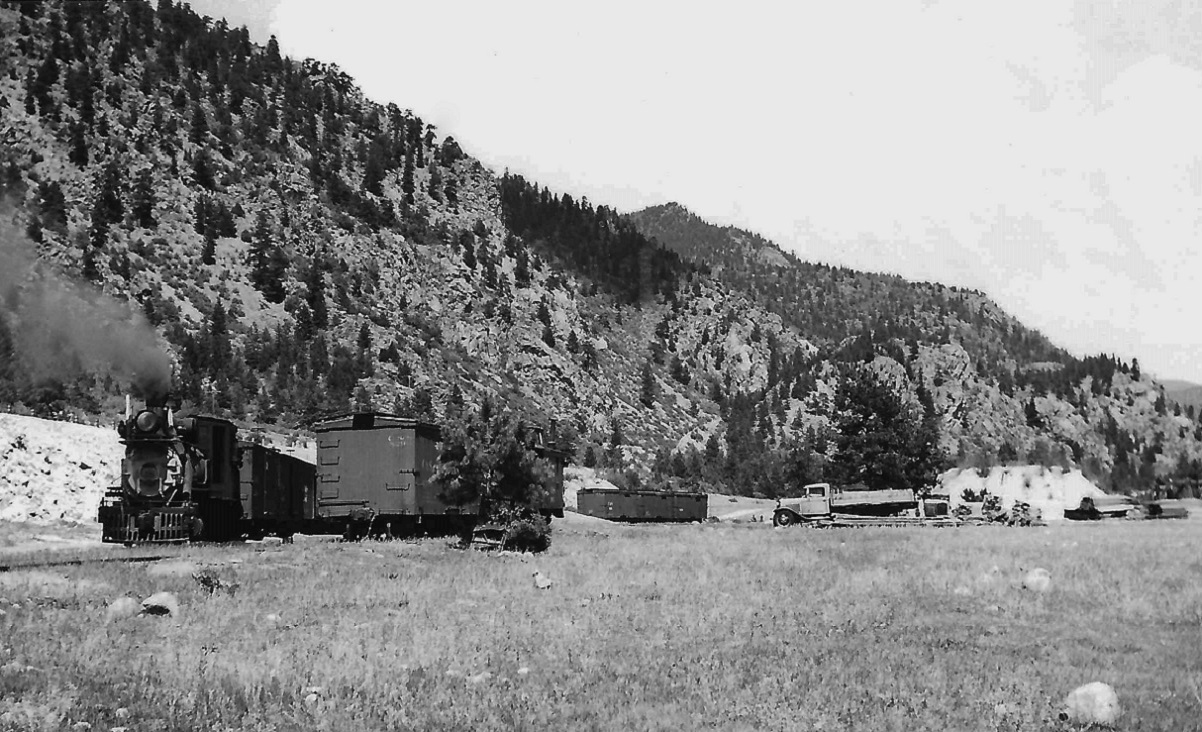 Maxwell negative: RHK-3 (This photograph may have been taken by Richard Kindig). The freight, down to 2 cars and caboose, crosses the High Bridge on the Loop in a somewhat blurry photo: 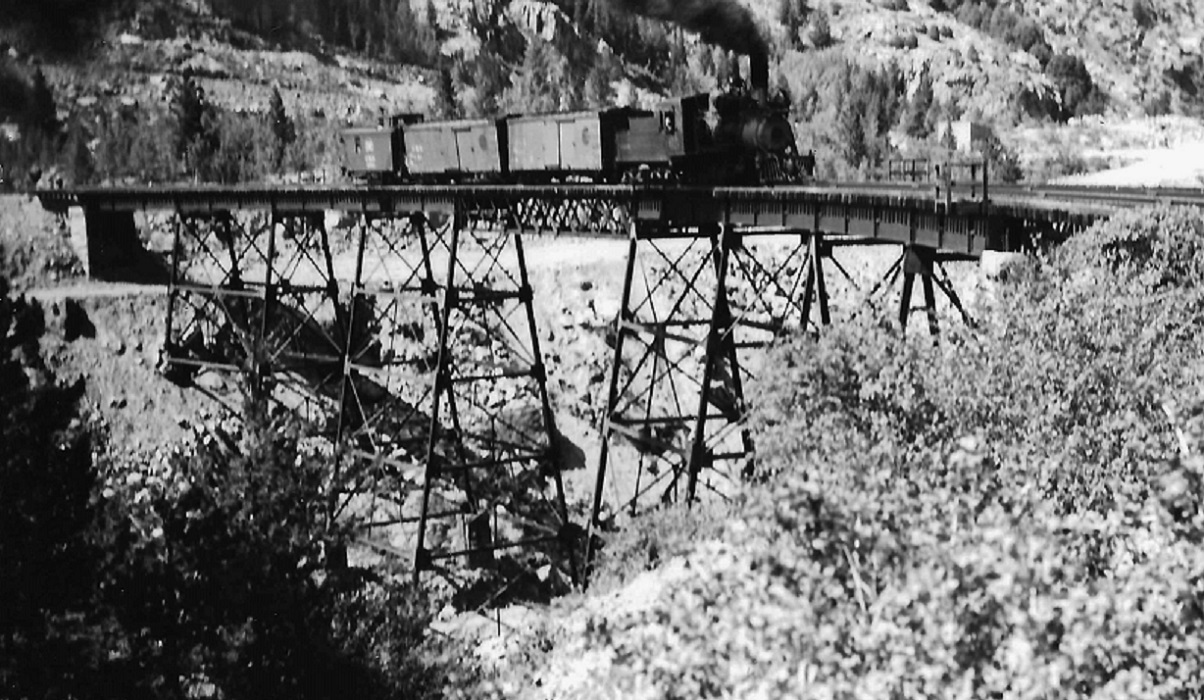 Maxwell negative: MSK-23 (This photograph may have been taken by Richard Kindig). After switching the Silver Plume yard and turning on the wye, number 65 gets oiled by the engineer while the conductor finishes up paper work at the depot: 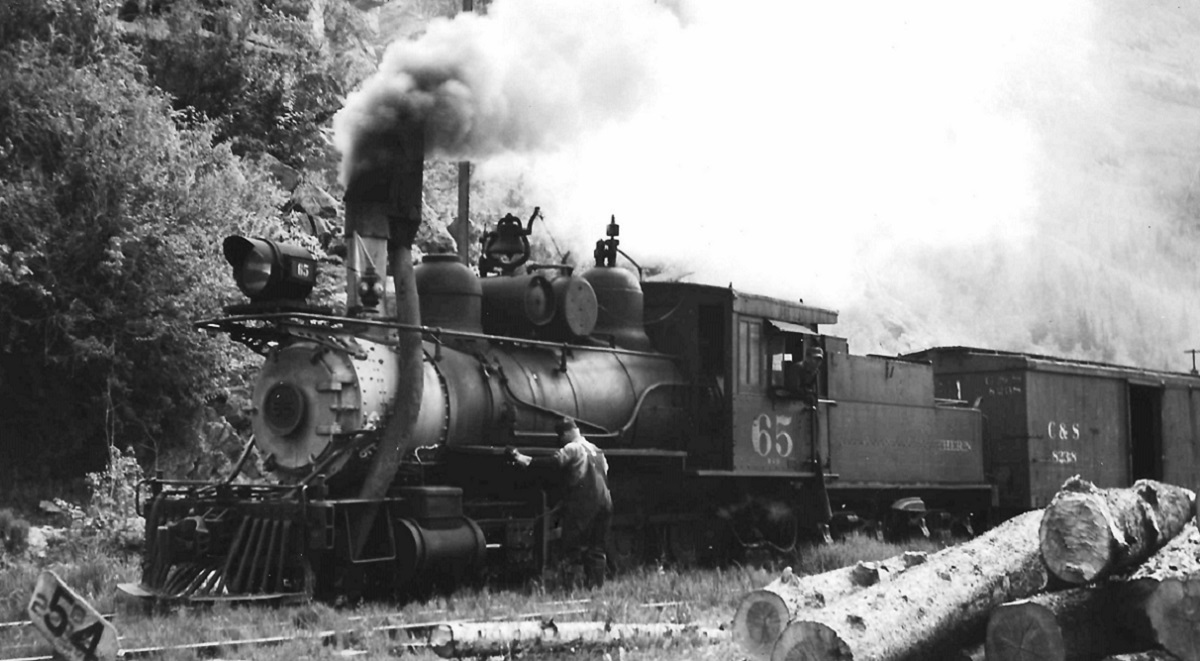 Maxwell negative: MS-K-20 (This photograph may have been taken by Richard Kindig). The down train is a bit longer for the return to Denver, but all empties. Note that refrigerator cars still made it up to Silver Plume as late as 1938: 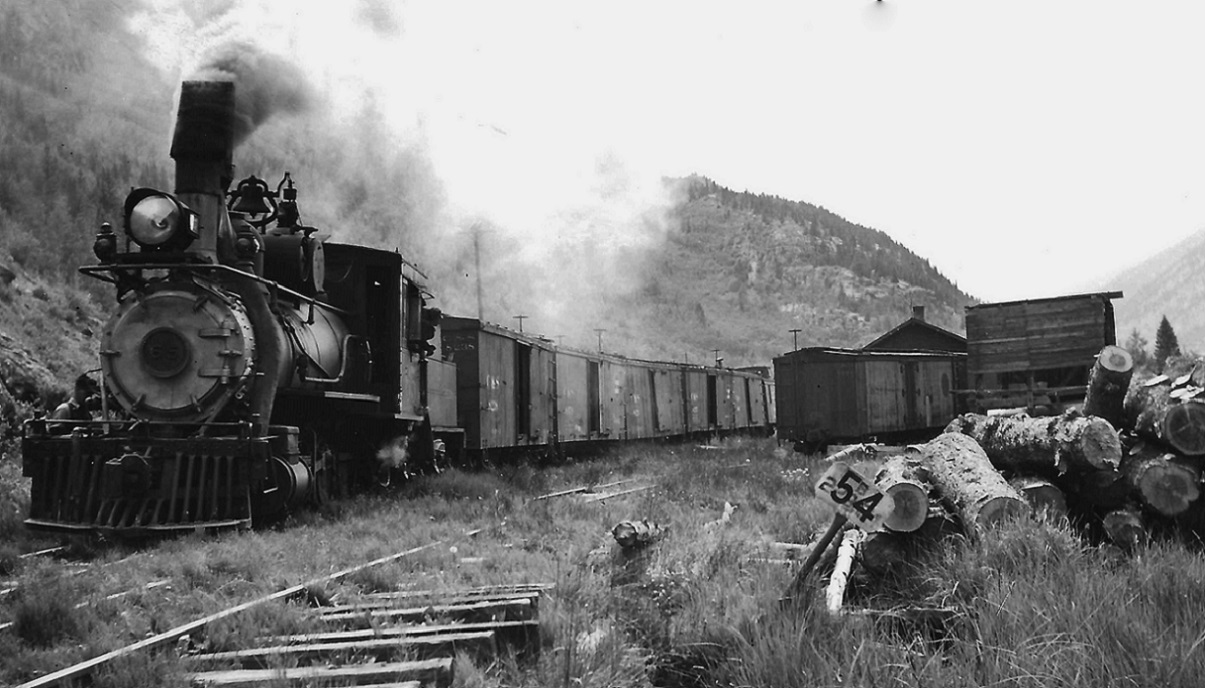 Maxwell negative: RHK-4 (This photograph may have been taken by Richard Kindig). Number 65 still waits to depart Silver Plume, the fireman looking back for the conductors signal: 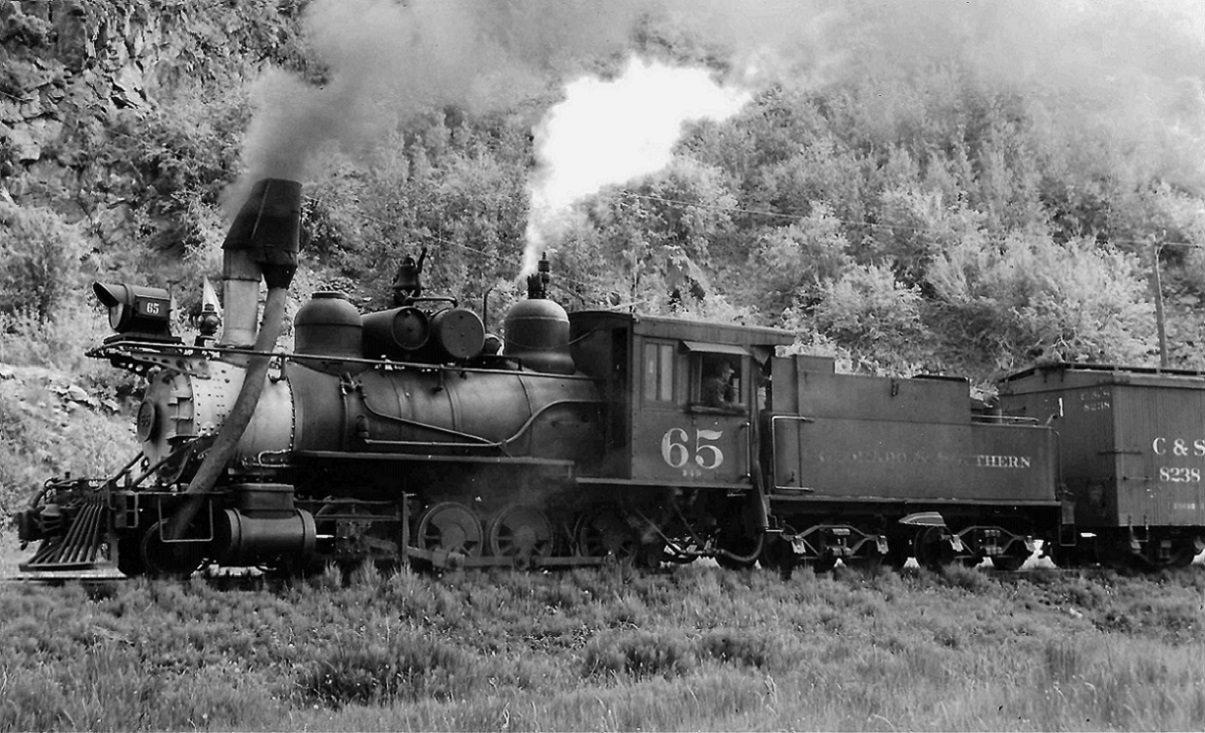 Maxwell negative: HG-65 (This photograph may have been taken by Henry Griffiths). On September 29, 1938, C&S 68 and caboose 1003 were spotted, fires dumped, at Idaho Springs. The caption on the back of the print says they were stranded here due to a washout to the east:  Maxwell negative: JCT-1 (This photograph may have been taken by Jackson Thode). An overview of Forks Creek on June 2nd, 1940:  Maxwell negative: 98. After the Clear Creek line was abandoned beyond Idaho Springs, occasional freights still ran, often with number 70 as the power. Due to lack of a wye at Idaho Springs, the 70 usually pulled the train tender first above Forks Creek. On New Years Day of 1941, at "11:22 AM", Maxwell photographed this short westbound train on one of the bridges in the Floyd Hill area (Chris can probably tell us which one):  Maxwell negative: 620. On April 10, 1941, Maxwell caught some switching action at Forks Creek, as the train was rearranged for the Blackhawk and Idaho Springs segments. CONX 8 was front and center:  Maxwell negative: 923. Finally, on May 4, 1941 the last scheduled C&S freight ran to Idaho Springs. Maxwell caught number 70 backing across north wye bridge at Forks Creek, turning, before proceeding tender first to Idaho Springs: 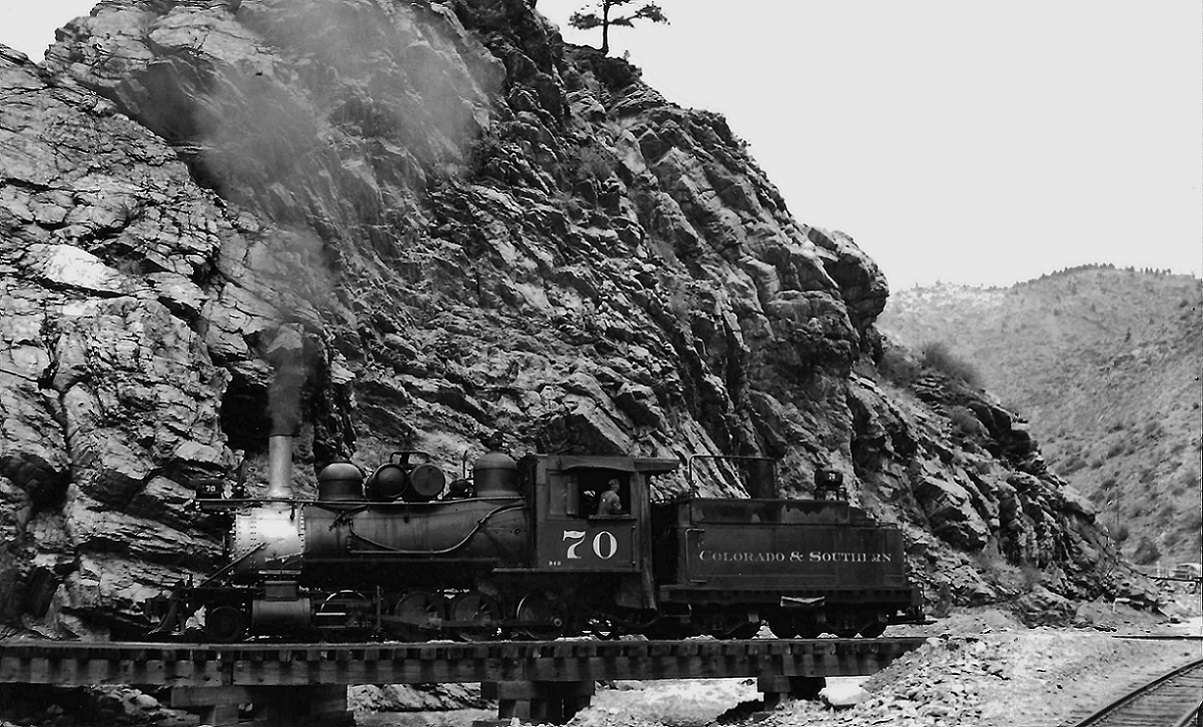 Maxwell negative: 1020. But there were still the scrapping trains. Sometime later in 1941, the photographer found C&S 69 in "East Idaho Springs" (per caption). Phase 2 coal car number 4481 remains in the C&S block lettering scheme until the very end:  Maxwell negative: KK-81 (photographer uncertain). Over in Leadville (see "C&S in Color": http://c-sng-discussion-forum.41377.n7.nabble.com/C-amp-S-Narrow-Gauge-in-Color-td5158.html), in July of 1941, the photographer documented converted flat car 4511, a former SUF coal car, on the three rail track behind the depot: 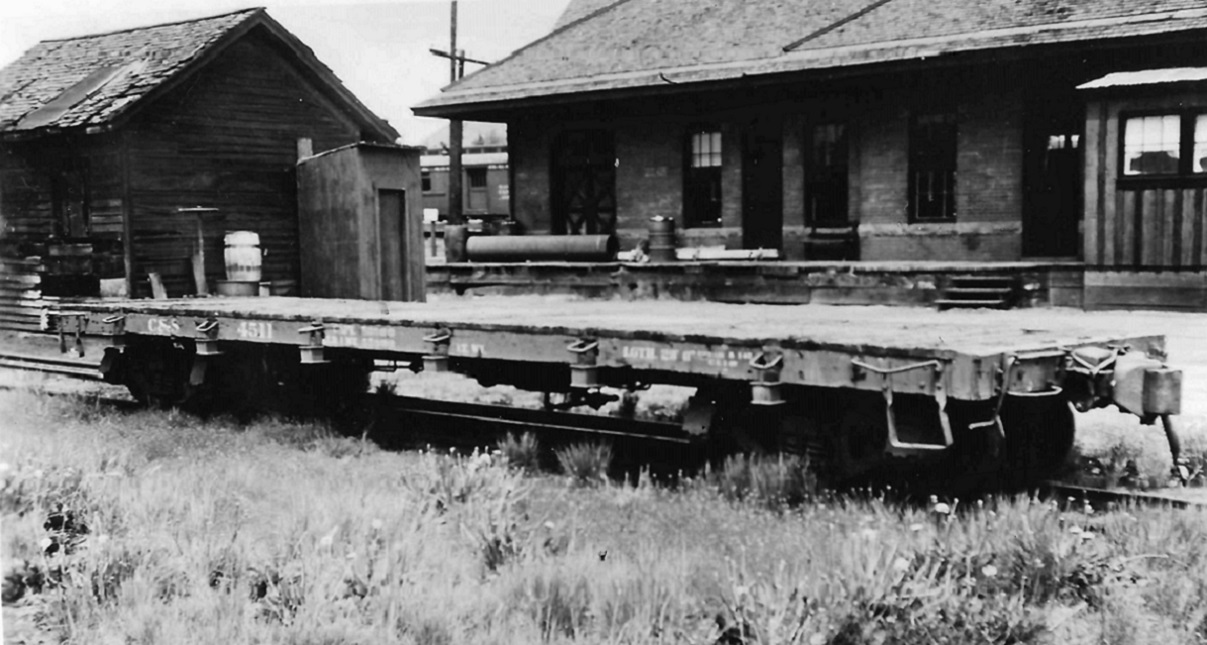 Maxwell negative: KB511 (photographer uncertain). Anyways, that's all the Maxwell prints that I have, thought I should post them here before I lose them again!
Jim Courtney
Poulsbo, WA |
Re: Up Clear Creek with John Maxwell
|
Ahem...that three-rail track behind the depot" is actually the end of the main line, such as it is.
Keith Hayes
Leadville in Sn3 |
Re: Up Clear Creek with John Maxwell
|
I thought the track behind the depot (with the stand pipe) was the original Colorado Midland connecting track, to allow standard gauge cars from the LMB to reach the Colorado Midland. Am I mistaken (again)??
BTW, the sand house could use a new roof.
Jim Courtney
Poulsbo, WA |
Re: Up Clear Creek with John Maxwell
|
This post was updated on .
In reply to this post by Keith Hayes
Thank you Jim,
Wow, what a lunchtime surprise, Thanks for these, there is a deja vu feeling with some of them, used by Harry Brunk I guess. The Bridge you asked about is the #711 originally the #10.
UpSideDownC
in New Zealand |
Re: Up Clear Creek with John Maxwell
|
Okay, I'm feeling a bit stupid here!.
I was impressed at how the scanned images turned out from such small prints. But like Chris, there was a weird sense of deja vu. So I got out my dog eared copy of CRA 10, "Narrow Gauge to Central and Silver Plume" to look for more Maxwell photos, and I found some. But I found many other photos of the 1938 train to Silver Plume behind number 65, eight to be exact, but by two other photographers: Richard Kindig and H. R. Griffiths. But none by John Maxwell. So I began to wonder, did Maxwell ride along with one or both photographers on this attempt to chase one of the last freight trains over the Loop, and his photos didn't make the cut for the Annual? Or maybe the photos above weren't really his! I purchased all the above posted prints from Maxwell in the early 1970s, ordering from his negative list, with no attribution to other photographers. He even hand printed captions on the back of the prints (most were printed on RC style paper, popular in the day). But when I just looked at the negative number that Maxwell marked on the prints, some were suspicious: "MS-K 20, MSK 23, MS-K-22, RHK3, RHK4 and HG-65." I now suspect that John Maxwell obtained the negatives (or duplicates of the negatives) from Kindig and Griffiths, and used the negatives to later sell prints. So tomorrow I will go back and edit the original post to indicated possible attribution to the actual photographers.
Jim Courtney
Poulsbo, WA |
Re: Up Clear Creek with John Maxwell
|
In reply to this post by Jim Courtney
Yes, it is, but really seems like the main.
Keith Hayes
Leadville in Sn3 |
Re: Up Clear Creek with John Maxwell
|
In reply to this post by Jim Courtney
Thanks for your scholarship, Jim.
I have been pondering of late why it is Dick Kindig who was an affable model, more apt to pose for a photo than the others?
Keith Hayes
Leadville in Sn3 |
Re: Up Clear Creek with John Maxwell
|
This post was updated on .
In reply to this post by Keith Hayes
That track has always puzzled me. From the late 20s on it seems like a "ready track", with all the motive power spotted there in photos, even though the roundhouse was at the other end of the yard.
What do you think really happened? Did the incoming power leave the train in the yard and all the locomotives then proceed to the track behind the depot where the engine crews tied up? Did the hostlers then take over, turn the locomotives, coal them, water them and then spot them back on the track behind the depot for the return to Denver the next morning? Did the arriving and departing motive power actually spend the night in the roundhouse, or was that only for the Leadville switcher? Maybe Mike Trent could shed some light on how the locomotives were serviced in the 1930s.
Jim Courtney
Poulsbo, WA |
Re: Up Clear Creek with John Maxwell
|
Good questions, Jim.
I suspect after the connecting track with the Midland and the mines to the south fell into disuse, there was no real excuse to use the track south of East Seventh Street (the street that abuts the depot block). The current parking lot east of the depot where the 638 is spotted always puzzled me until I saw the valuation maps. This was a four-track stub yard adjacent to the depot. It was all narrow gauge track and there were platforms between the eastern-most three tracks to assist unloading. This seems to be where cars were stored, notably the combine that was stranded in Leadville after abandonment of the line east of Climax. Photogs seem to have snapped a bunch of car photos on these tracks. The water plug was located directly west of the depot (city water), and there was a small coal shed (for the depot?). Coal and sand was located along the leads to the roundhouse. There is also an ash pit on track 3. (In the photo with the Denver Water Board train, folks in another string noted the presence of a water tank in the vicinity of the roundhouse, but this is not indicated on the valuation map, so perhaps it was not a C&S structure.) My thesis is that locomotives tied up their trains, did some switching, perhaps got some water and headed for the roundhouse for the night. In the morning, they would dump ashes, get coal and sand and head to the depot for water--I think this is why we see so many images of locomotives standing by the water plug. Seems like the crews got in late and thus had a later call eastbound, so the loco would be at the plug at 9 or 10 am with some sun on the east side: ideal for a portrait! The Leadville yard is actually a neat, compact servicable yard. There are four through tracks (the two outer being dual gauge) and a runaround west of the freight depot that goes through the lumber yard. A scale is located north of the freight depot. The water plug is on the south lead to this yard, so it probably had to stay in service in order to switch the south end of the yard. I find on my layout, I tend to use the south lead most, in part because it is complete.
Keith Hayes
Leadville in Sn3 |
Re: Up Clear Creek with John Maxwell
|
This post was updated on .
BTW Keith,
In the file cabinet, I found packets of processed B&W negatives from a 1984 trip to Leadville, that I never printed. I believe there are multiple frames of the freight house (then part of a lumber yard), from all sides. One image seems to capture the B&W on barn red sign on the end of the freight house. Any idea who would print old 35mm B&W negatives in this day and age? If I can get them printed, I'll send you copies or post them here on a new thread. I know the passenger depot is a work in progress, but it is never too soon to start planning that freight house!
Jim Courtney
Poulsbo, WA |
Re: Up Clear Creek with John Maxwell
|
Jim,
We have a full service photo studio in Spokane called "Wirsché" on Indiana. They do all the reprint work for the Eastern Washington Historical Society and others. I can get you a POC if you like.
"Duty above all else except Honor"
|
Re: Up Clear Creek with John Maxwell
|
In reply to this post by Jim Courtney
Jim, sadly the print photograph business is becoming smaller and smaller.
If I had to get some film today, I am not sure where to go, though I know it is still available. Likewise for printing supplies. This is unfortunate, as it is not a difficult art to master, and can provide a lifetime of pleasure (and frustration). When we did the C&TS National Register update and Landmark nomination, I was able to locate a lab in Lakewood. For years NPS (smartly) considered B+W prints the archival standard. Commerce moved faster than NPS, and now they are stuck with the rest of us, wondering what digital format will prove lasting.
Keith Hayes
Leadville in Sn3 |
«
Return to C&Sng Discussion Forum
|
1 view|%1 views
| Free forum by Nabble | Edit this page |

